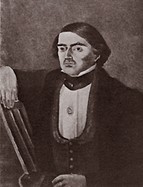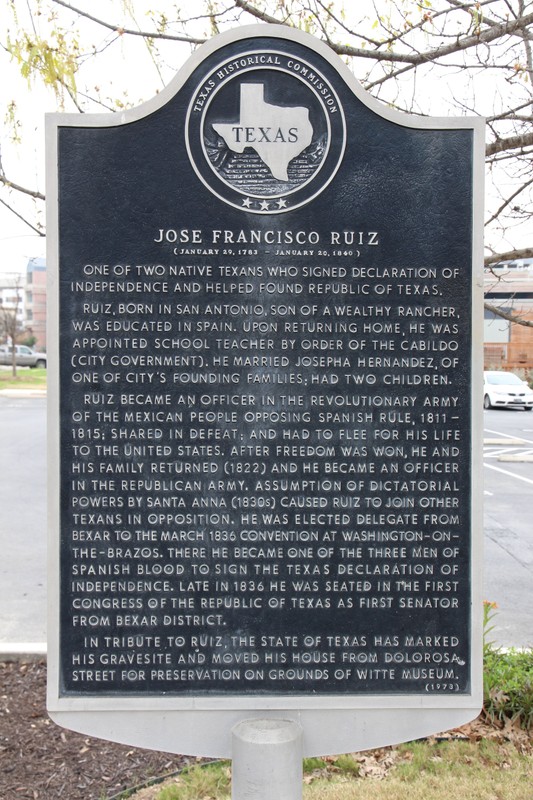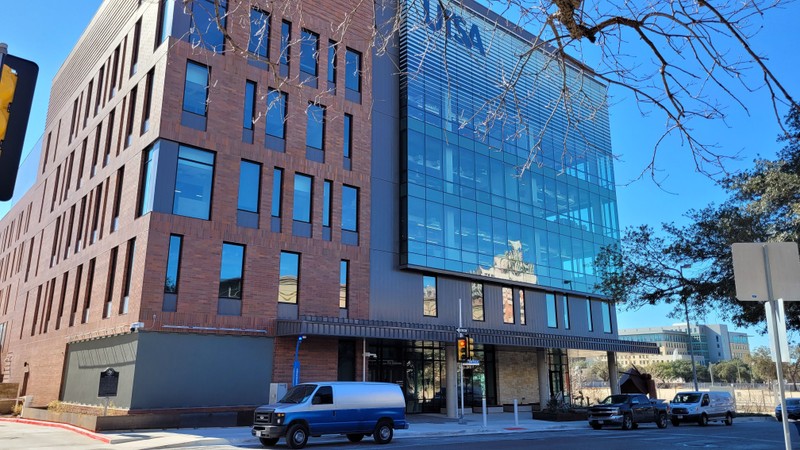Jose Francisco Ruiz Historical Marker
Introduction
Text-to-speech Audio
This historical marker commemorates politician, teacher, and military officer, Jose Francisco Ruiz (1783-1840), who participated in the Mexican War of Independence from Spain (1811-1815) and was a key figure in the Texas Revolution (1835-1836) against the Mexican government. Ruiz was one of only two native Texans who signed the Texas Declaration of Independence. He is also known for teaching in the first school in San Antonio, serving as an interpreter and negotiator with the Comanche Indians, and for his civic and business activities. The marker is located just outside of the University of Texas-San Antonio San Pedro 1 building.
Images
Jose Francisco Ruiz (1783-1840) is an important figure in Texas history. He was one of only two native Texans to sign the Texas Declaration of Independence and served in the First Congress of the Republic of Texas.



Backstory and Context
Text-to-speech Audio
Jose Francisco Ruiz was born on his family's ranch on January 29, 1783 in San Antonio, which was then a Spanish fort called the Presidio San Antonio de Béxar and located in the province of Spanish Texas. His parents were Juan Manuel Ruiz and María Manuela de la Peña. It appears he well educated and, apparently, completed his schooling in Spain. He became the schoolmaster of San Antonio in 1803 and taught in the family house (the house survived and was relocated in 1943 to the Witte Museum where it is open to the public). Two years later, Ruiz was elected to serve on the city council.
He began his military career in 1811 when he joined the Béxar Provincial Militia with the rank of lieutenant. He later joined the Republican Army and fought against the Spanish crown on August 18, 1813 at the Battle of Medina, which Spanish forces won. The Spanish general placed on bounty on Ruiz's head, forcing Ruiz to flee and live in exile. Until around 1822, he moved around and spent a long period of time with the Comanche Indians. In 1821, Mexican Emperor Agustín de Iturbide ordered Ruiz to negotiate peace with the Comanches and Lipan Indians. After returning to Texas in 1822, he was appointed to the mounted militia. In 1824, he was promoted to captain with the rank of lieutenant colonel. In 1826, he was sent to command a post in Nacogdoches and help quell a rebellion there. In the late 1820s, back in San Antonio, Ruiz wrote a book called the "Report on the Indian Tribes of Texas."
In 1830, Ruiz was ordered to command Fort Tenoxtitlán, which was located in present-day Burleson County, to prevent more Americans from settling in Texas. It was an unenviable post. The fort was isolated and vulnerable to attack, and obtaining food was difficult. Soldiers often deserted as well. In 1832, Ruiz was permitted to abandon the fort and returned to San Antonio. He retired and received his military pay from the Mexican government.
During the next few years, Ruiz turned against Mexico and became a supporter of Texas independence. In February 1836, he served as one of the 59 delegates to the Convention of 1836 in Washington-on-the-Brazos, Texas, where the Texas Declaration of Independence was written. It was there that Ruiz and the only other delegate born in Texas, José Antonio Navarro, signed the Declaration on March 2. The last major engagement of the revolution was the Texian victory at the Battle of San Jacinto on April 21, which cemented Texas' independence. However, Mexico never officially recognized the Republic of Texas. Ruiz was elected as senator to the First Congress of the Republic in October and served until September of the next year.
Ruiz was married and had four children, one of whom was Francisco Antonio, who was the alcalde (magistrate) of San Antonio during the Battle of the Alamo. Ruiz owned land in and around San Antonio as well in other counties. He died on January 19, 1840 in San Antonio.
Sources
Bernice Strong, “Ruiz, José Francisco.” Handbook of Texas Online. Accessed March 30, 2023. https://www.tshaonline.org/handbook/entries/ruiz-jose-francisco.
Jennings, Frank W. "Jose Francisco Ruiz and his Decades-Long Fight for Texas Independence." University of the Incarnate Word. Accessed March 30, 2023. https://www.uiw.edu/sanantonio/jenningsruiz.html.
"Jose Francisco Ruiz." The Historical Marker Database. Accessed March 30, 2023. https://www.hmdb.org/m.asp?m=130094.
"Tejano Founding Fathers — José Antonio Navarro and José Francisco Ruiz." Medium. October 13, 2016. https://medium.com/save-texas-history/tejano-founding-fathers-jos%C3%A9-antonio-navarro-and-jos%C3%A9-francisco-ruiz-7582af98229d.
Wikimedia Commons
The Historical Marker Database
